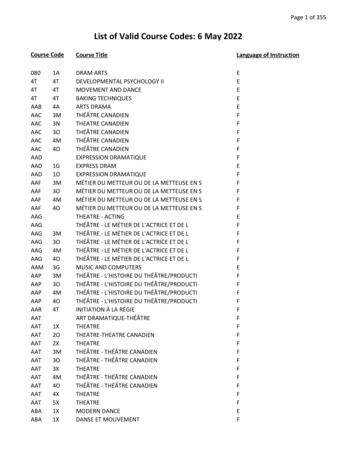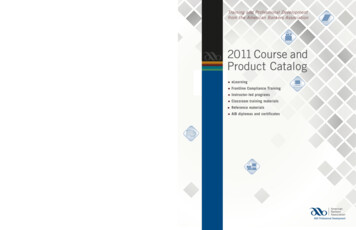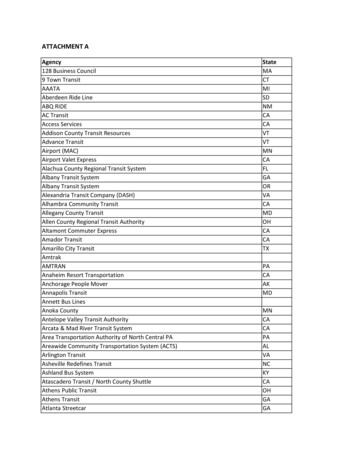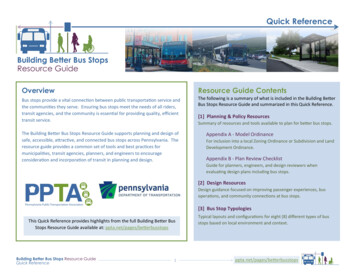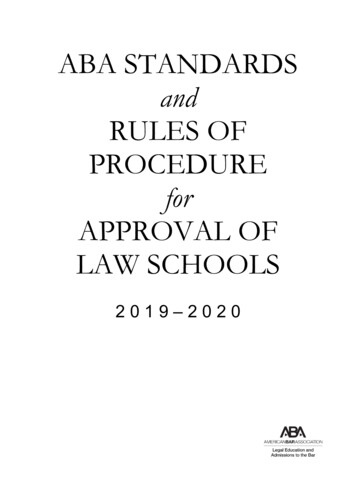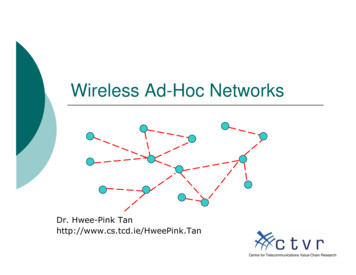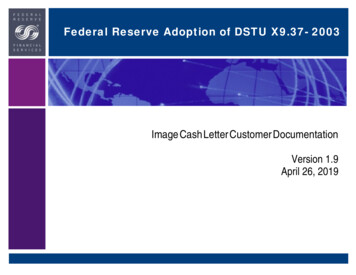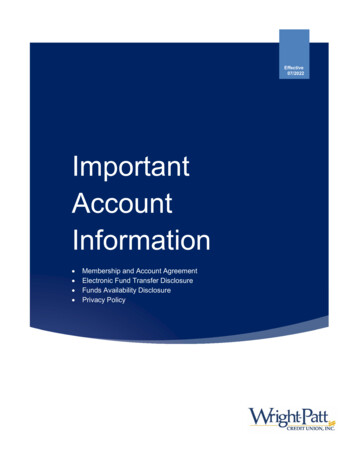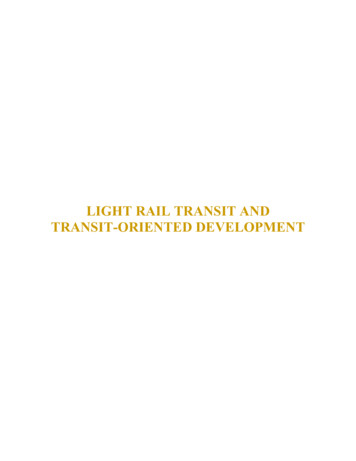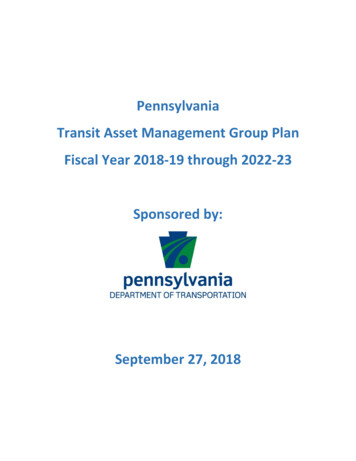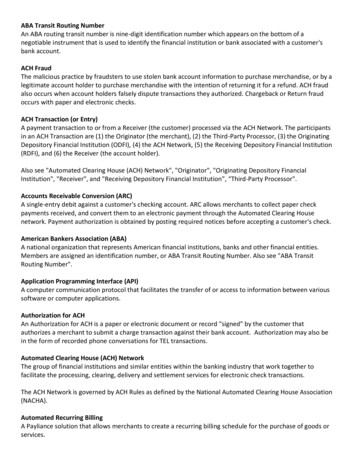
Transcription
ABA Transit Routing NumberAn ABA routing transit number is nine-digit identification number which appears on the bottom of anegotiable instrument that is used to identify the financial institution or bank associated with a customer'sbank account.ACH FraudThe malicious practice by fraudsters to use stolen bank account information to purchase merchandise, or by alegitimate account holder to purchase merchandise with the intention of returning it for a refund. ACH fraudalso occurs when account holders falsely dispute transactions they authorized. Chargeback or Return fraudoccurs with paper and electronic checks.ACH Transaction (or Entry)A payment transaction to or from a Receiver (the customer) processed via the ACH Network. The participantsin an ACH Transaction are (1) the Originator (the merchant), (2) the Third-Party Processor, (3) the OriginatingDepository Financial Institution (ODFI), (4) the ACH Network, (5) the Receiving Depository Financial Institution(RDFI), and (6) the Receiver (the account holder).Also see "Automated Clearing House (ACH) Network", "Originator", "Originating Depository FinancialInstitution", "Receiver", and "Receiving Depository Financial Institution”, “Third-Party Processor".Accounts Receivable Conversion (ARC)A single-entry debit against a customer's checking account. ARC allows merchants to collect paper checkpayments received, and convert them to an electronic payment through the Automated Clearing Housenetwork. Payment authorization is obtained by posting required notices before accepting a customer's check.American Bankers Association (ABA)A national organization that represents American financial institutions, banks and other financial entities.Members are assigned an identification number, or ABA Transit Routing Number. Also see "ABA TransitRouting Number".Application Programming Interface (API)A computer communication protocol that facilitates the transfer of or access to information between varioussoftware or computer applications.Authorization for ACHAn Authorization for ACH is a paper or electronic document or record "signed" by the customer thatauthorizes a merchant to submit a charge transaction against their bank account. Authorization may also bein the form of recorded phone conversations for TEL transactions.Automated Clearing House (ACH) NetworkThe group of financial institutions and similar entities within the banking industry that work together tofacilitate the processing, clearing, delivery and settlement services for electronic check transactions.The ACH Network is governed by ACH Rules as defined by the National Automated Clearing House Association(NACHA).Automated Recurring BillingA Payliance solution that allows merchants to create a recurring billing schedule for the purchase of goods orservices.
Back Office Conversion (BOC)A one-time debit against a customer's checking account. BOC allows merchants to collect a check written at apoint of sale and convert it to an ACH debit during back office processing. Payment authorization is obtainedby posting required notices before accepting a customer's check.Bank Account NumberThe account number assigned by a bank to a checking or savings account holder. This information must beprovided to a merchant by a customer in order to make an electronic check payment.Bank Account TypeThis indicates the type of bank account used for an electronic check transaction. For example: checking,business checking or savings.Batch UploadA process for submitting multiple transactions at once from a comma separated value (.csv) file or proprietarybusiness application.Cash Concentration or Disbursement (CCD)A debit or credit transaction against a business checking account. One-time or recurring CCD transactions arefund transfers to or from a corporate entity and authorized by an agreement between two businesses.Return Reason CodeA code provided to the merchant by the Receiving Depository Financial Institution (RDFI) that indicates thereason for the returned transaction.Check 21Refers to the Check Truncation Act of the 21st Century, a Federal Reserve Bank law that allows merchants tosubmit customers' check, or bank account, information for payment electronically instead of processing paperchecks.Bank Account VerificationA risk management process that validates consumer account information and reduces potential fraud andnon-sufficient fund returns.Cut-Off TimeThe time of day that a merchant's payment transactions are batched and electronically picked up by thepayment gateway for processing. The Payliance default payment cut-off time for RCC processing is 8:00 PMEST, for ACH processing is 8:30 pm EST.Depository Financial Institution (DFI)An Originating Depository Financial Institution (ODFI) or Receiving Depository Financial Institution (RDFI) (or ingeneral terms, a bank) participating in the ACH Network.Discount FeeThe percent of each transaction processed that is billed to the merchant by Payliance. The transaction typesfor which the discount fee is charged are: charges, refunds, voids and declines.
Electronic CheckDescribes a check or bank account payment that is submitted and/or processed electronically.Electronic Funds Transfer ActThe United States federal law that governs the use and administration of electronic funds transfer services.Electronic Signatures in Global and National Commerce Act (E-SIGN)A United States federal law that defines and governs the use of digital signatures and records in electroniccommerce.Federal Reserve Bank (FRB)The governing financial institution of the United States of America.Independent Sales Organization (ISO)An organization that sells business products or services to merchants and/or acquires merchants on behalf ofvarious types of merchant service providers.Internet-Initiated Entry (WEB)A single or recurring debit entry charge against a customer’s checking or savings bank account. Paymentauthorization is obtained from the customer via the Internet.Mail Order/Telephone Order (MOTO)A business, or merchant, that sells merchandise or services to consumers via mail or telephone initiatedorders. MOTO merchants operate from call or fulfillment centers.Manual EntryThe submission of payment information for a transaction is obtained by keying the customer's paymentinformation into a hardware or Virtual Terminal. Additionally, for online merchants a manual transactionmight be considered any transaction that is not entered at their e-commerce Web site by a customer.MerchantThe person or business entity that sells goods or services to a customer.Merchant Account ProviderA financial institution, or bank, that provides a financial account to a merchant for-the-purpose- of collectingproceeds from consumer bank account.Merchant Identification Number (MID)An identification number assigned to each member merchant of an acquiring organization, such as a financialinstitution, Independent Sales Organization (ISO), Merchant Service Provider (MSP) or processor.Merchant Service Provider (MSP)A company or sales organization that provides transaction processing solutions to its merchant clients.Minimum Monthly FeeA monthly service fee charged by Payliance in-the-event that a merchant's transaction processing fees for themonth do not exceed the monthly minimum fee amount. For example, if the merchant's minimum monthlyfee is 20.00, and the merchant's transaction processing fees (i.e., per-transaction fees and discount fees) for
the month total 17.50, Payliance will charge the merchant a Minimum Monthly Fee of 2.50 to make up thedifference. If the merchant's transaction processing fees for the month exceed 20.00, the fee is not charged.National Automated Clearing House Association (NACHA)NACHA is the national trade association that establishes the rules, standards, and procedures governing theexchange of ACH transactions between participating banks (Originating Depository Financial Institutions andReceiving Depository Financial Institutions).Not Sufficient Funds (NSF)A return indicating that a customer's bank account does not have sufficient funds to cover a specifictransaction.Notification of Change (NOC)Notification to a merchant from a customer's bank indicating that bank account information provided with aspecific transaction needs to be updated to reflect current information.Originating Depository Financial Institution (ODFI)The financial institution that originates the transaction into the ACH network on behalf of the originator(merchant) for clearing through the receiver (customer) account.OriginatorThe entity that has received authorization from a receiver (customer) to create a debit or credit their account.Payment GatewayA system of technologies and processes that allow merchants to electronically submit payment transactions tothe payment processing networks (i.e., the Credit Card Interchange and the ACH Network). Payment gatewaysalso provide merchants with transaction management, reporting, and billing services.Per-Transaction FeeThe flat fee charged to a merchant by the payment gateway for each transaction and batch settlementprocessed. The transaction types for which the per-transaction fee is charged are: charges, refunds, voids anddeclines.Point of Sale (POS)Refers to the physical location where a payment transaction takes place. POS is also used to describe paymentacceptance systems that are designed for the place of sale, such as virtual terminals.Point of Sale (POS) DeviceA piece of electronic equipment that is used by a merchant to submit payment information to the processingnetwork. POS devices also include Personal Digital Assistants (PDAs), smartphones, and wireless electronicdevices capable of transmitting payment information via wireless broadband connection.Point of Sale (POS) Solutions ProviderA POS device, system or software manufacturer or distributor that provides POS products or services tomerchants.
Prearranged Payment and Deposit Entry (PPD)A single or recurring debit/credit transaction against a customer’s checking or savings account. PPDtransactions may only be originated when payment and deposit terms between the merchant and thecustomer are prearranged and “signed” authorization has been provided by the customer.ReceiverThe person or corporate entity that has authorized a merchant to initiate a debit or credit transaction to theirbank account. In a Payliance transaction, the customer is the "Receiver".Receiving Depository Financial Institution (RDFI)The customer's bank or credit union. The RDFI receives a request from the ACH Network to provide fundsbased on an authorization provided to a merchant for goods and/or services and processed by Payliance.Recurring Billing TransactionThe submission of a transaction on a recurring basis, typically for ongoing billing or subscription-basedpayment activities requested and authorized by the receiver (customer).Reference Transaction IDThe transaction ID that links, or associates, a subsequent transaction to a separate, original transaction.Regulation DPart of the Reserve Requirements of the Depository Institutions Act as established by the Federal ReserveBoard. Regulation D defines the types of deposits handled by financial institutions, or banks.Regulation EPart of the Electronic Funds Transfer Act as established by the Federal Reserve Board. Regulation E defineselectronic funds transfers and the protections provided to the consumer when processing ACH transactions.ResellerA Merchant Service Provider (MSP) or Independent Sales Organization (ISO) that acquires merchant customersfor payment processing services.Return or Returned ItemA transaction that could not be completely processed for reasons such as NSF, invalid account number,account closed or other rejection reason(s) provided by the customer's bank. A chargeback is a type of return.Also see "Chargeback".SettlementOccurs when monetary proceeds for a merchant's Payliance transactions are deposited to the merchant'sbank account.Standard Entry Class (SEC) CodesA required code used in the ACH Network indicating how the receiver (customer) authorized a payment.Examples: WEB, TEL, PPD, CCD, BOC, POP, ARC, POP, POS, etc.Telephone-Initiated Entry (TEL)This transaction type is a one-time charge against a customer checking or savings account. TEL transactionsmay only be originated when a business relationship between the merchant and the customer already exists;or if no relationship exists, only when the customer initiates the telephone call to the merchant.
Third-Party ProviderAn organization or business not directly associated or involved with transaction processing, or necessary forthe exchange of a transaction between two parties, but that provides merchants with business enhancingservices.Third-Party SolutionA hardware or software manufacturer or distributor that provides transaction-enhancing products orprocessing solutions to merchants.TransactionThe exchange of information, goods or services in which all participating parties benefit. Specifically, theexchange of a consumer's payment or payment information for merchandise or services provided by abusiness.Unauthorized ReturnAn unauthorized return is a type of return that occurs when an account holder claims they did not authorize atransaction, when the account holder and the customer are not the same person (i.e., identity theft), whenthe authorization was not properly obtained from your customer or when your customer does not recognize atransaction.UnderwritingThe process of evaluating a service applicant's financial history and credit trustworthiness to determinewhether to grant a service account.Virtual TerminalA Merchant Interface tool for manually keying in and submitting transactions.VoidTransactions of this type are used to cancel original charge transactions that have not yet been submitted tothe ACH Network. To cancel a transaction that has already submitted, a refund must be processed.
Return Reason Code A code provided to the merchant by the Receiving Depository Financial Institution (RDFI) that indicates the . (NACHA) NACHA is the national trade association that establishes the rules, standards, and procedures governing the . Codes A required code used in the ACH Network indicating how the receiver (customer) authorized .
